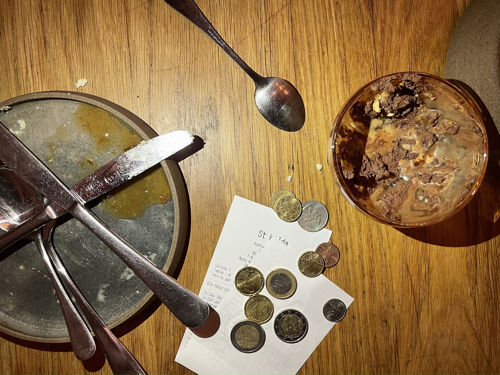“Here, in the United States, I see French tourists parading around like royalty when they leave five bucks on the table for a two-hundred-dollar bill… Buddy, it’s broken down at the bottom of your check, ‘tip 15%, 18%, 20%, 22%.’ Make an effort, open up your Routard travel guide when you come here,” exclaims the 30-year-old waitress Estelle Monbi, seated across the table from me at a Brooklyn café. The two of us work in the same field, at least part time anyways. And we’ve both done so first in France, then in the United States. Estelle, Parisian by birth and New Yorker by choice, is a Swiss army knife of a woman, sharpened by her experiences in the hospitality industry. She started working in bars in the French capital when she was 17, counting change left behind by customers at the end of the night, before moving abroad to work as a waitress and bartender in the Big Apple’s most stylish spots – she currently works at Sauced, a trendy Williamsburg wine bar. And like most servers in the United States, she’s noticed a pattern: the French don’t know how to tip!
A simple misunderstanding, pure ignorance or a lack of respect for American customs? At the New York restaurant where I’ve been working for the past year, I often try to excuse my compatriots’ behavior to my colleagues: in France, leaving a big tip is not the norm. But when they question me about the customs of my home country, I often find them hard to explain. I’m not the only one: the financial newspaper Les Échos described the French tipping style as a “real headache.” If it was customary in the past to leave a little change for the waitstaff after a meal, that habit appears to be disappearing, especially among young people. Why? You might consider the pandemic, the disappearance of “pocket change” and the ubiquity of payment by credit card as possible explanations.
“Despite an average bill of €107, it’s fairly common for us to have collected zero tips by the end of a meal, even if people tell us they had a great time and really enjoyed themselves,” remarks Fredric, the director of a Parisian neo-bistro. Based in Paris for three and a half years now, this American has crunched the numbers: over the past four months, the average amount of tips received represents less than 3% of the total bills. “Do you know any waiters who make a good living in Paris?” he asks me. “Personally, I don’t. Most of them earn minimum wage,” – roughly €1,500 net per month for a 39-hour work week. But for the last year, tips left via credit card have been tax-exempt, a government initiative to make jobs in the deserted hospitality sector more attractive. Could the return of tipping actually change people’s perception of the profession and its precarious nature, so that it more closely resembles what is practiced on the other side of the Atlantic? Because in the US, tipping is synonymous with paying your bill.
700 dollars a night
“Customers don’t necessarily understand that when they leave a tip, they’re actually paying the salary of the person who just served them,” explains Teófilo Reyes of ROC United, an American not-for-profit organization that fights for better working conditions in the restaurant industry. As recently as 2020, only seven of the fifty US states required employers to pay their employees minimum wage. In twenty-four states, it is actually legal to pay them only two-thirds of the minimum wage. That’s the case in New York State, where I earn ten dollars an hour at my waitressing job, whereas the statewide minimum wage is set at fifteen dollars. Worse still, in the nineteen remaining States, salaries can drop as low as $2.13 an hour, all with full legal impunity for employers. These laws apply to all tipped workers, that is to say people who regularly receive tips. They work primarily in the restaurant industry, but you can also find them at carwashes and even nail salons.
Tips, which are generally equivalent to 20% of the meal or service provided, are supposed to compensate for this loss of earnings. They are split between waiters and the people working behind the bar, but not always shared with hostesses, who manage reservations and greet customers, or bussers, who set and clear tables over the course of a meal. Rare are the establishments that split tips with the kitchen staff, because the distribution of tips is based on (assumed) skills, and, more importantly, interaction with customers – the foundation upon which this entire system is built.
Is tipping a typically American practice? Not really. It’s actually a European import. Until the mid-19th century, many Americans felt the practice was anti-democratic and even tacky. But mentalities finally changed after the Civil War, when it became a question of compensating former slaves entering the labor market, often in the service sector. Employers took advantage of the lack of opportunity available to the Black population in order to pay them very little and leave the burden of their wages to the kindness and generosity of their customers. This system, despite major anti-tipping movements, became the norm by the early 20th century.
In the 2010s, certain restaurants attempted to change the established model and abolish these “gratifications,” before returning to the way it has always been. Blame it on the pandemic, which weakened an already fragile sector and generated the occasional contrarian reaction. On the one hand, the expansion of to-go sales has favored the introduction of tipping to places where it didn’t used to occur, like ice cream and coffee shops – a practice encouraged by payment apps like Square or Toast. Faced with this phenomenon, some Americans have begun complaining of “tipping fatigue,” a sense of frustration with the impression of always having to give more. On the other hand, the economic instability that resulted from the pandemic led certain restaurateurs interested in the fight for social justice to highlight the essential nature of their employees’ work, who for the most part, don’t have much job security. The most militant establishments are currently switching over to a tipless model, offering more attractive salaries in lieu of tips.
And yet some of my colleagues still appreciate the tipping system, associating it with a certain degree of freedom – even a source of pleasure. “You no longer want to do your job exclusively in Paris,” confesses Estelle Monbi, who was “shocked” by how much money she made after her first shifts in New York. Some nights, her earnings would soar as high as 600 or 700 dollars. “After experiencing that, I don’t think I’d be able to return to France and work in the restaurant industry. For me, it would be like working for free.”
Tipping, an economic system of its own
Rewarding for those who know how to “play the game” and work in establishments that attract a generous crowd, American-style tipping remains a complicated reality for most workers. Lucie Mezuret, who is a doctoral candidate in workplace and gender sociology at the Université Paris-Cité, is writing her thesis on the working conditions of waitresses in the United States. “Waitresses,” because the profession there is mainly female – two thirds of tipped workers are women. “It’s not simply the act of carrying a dish from the kitchen to the table correctly that is rewarded with a tip. It’s the fact that they are nice, pretty, smile easily and are friendly, because customers appreciate them,” explains the researcher, who is also working as a waitress while writing her thesis, and who describes this exchange as “giving part of yourself for financial gain.”
The rest won’t come as much of a surprise. A 2014 study by ROC United revealed that 80% of American restaurant workers have been subjected to some kind of sexual harassment from customers. Some bosses also encourage discriminatory sexist and “looks-based” dynamics. “It’s insane, the amount of effort that women have to go to obtain the money they deserve,” argues 27-year-old waitress Jordan Loomis in Tulsa, Oklahoma. She had just quit her job at a restaurant where the manager encouraged her to wear dresses to work, suggesting that the bartending team lacked “a female presence.” From the other side of the bar as well, the young Black woman has lost track of the number of comments she’s received on her appearance and the color of her skin: everyday, systemic racial discrimination is exacerbated by this practice. But employees of color are also less likely to obtain tipped positions, and when they do, they often receive fewer tips than their white colleagues.
Despite all this, Lucie Mezuret was surprised to learn that many of the waitresses she interviewed weren’t ready to renounce the tipping system just yet. “Coming from a European background, I assumed that the system should be banned,” recalls the PhD candidate, who currently works in a Parisian brasserie. “One of my waiter colleagues in France once said to me, ‘You know the expression ‘the customer is king?’ That’s not true. We chopped off the king’s head a very long time ago.’” In France, when you’re a waiter, you have more wiggle room, which allows you to be less friendly towards customers: you know that your livelihood isn’t on the line.” Estelle Monbi echoes this sentiment: “We do have this reputation for being rather unfriendly, and that’s because we don’t care: the pay is the same either way.”
Although in France, many members of the restaurant industry are trying to do away with this cliché (and are doing a pretty good job of it, too), there’s some truth to what Estelle and Lucie have to say: French bars and restaurants obviously depend on the presence of customers, but the salaries of their employees are not as intimately tied to their generosity – a reality reinforced by France’s social protections. In France, waiters benefit from a sort of “negative freedom,” that of not smiling, not performing for customers, in short, of not shining as social beings in order to obtain what is owed to them. The mentality of American waiters is more proactive: they’re forced to reinvent themselves every day, navigating a wobbly system and perhaps even gaining a lot of money in the process. That being said, given that our two societies interact more and more, the French could certainly take the opportunity to rethink their own relationship to tipping… Estelle’s conclusion? “In Paris, leave at least a 10% tip, it won’t break the bank!”
After a stint at Le Fooding, where she wrote such things as the investigative article “Lesbian genius is bubbling away in restaurant kitchens, too,” Ella Martin-Gachot is now a journalism student at NYU by day (classy!), and our informant on the American food-o-sphere by night.

